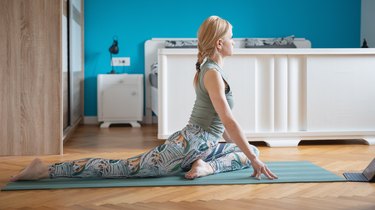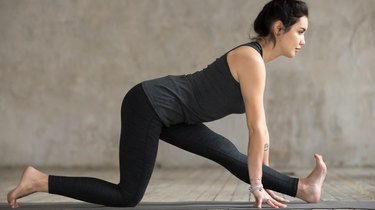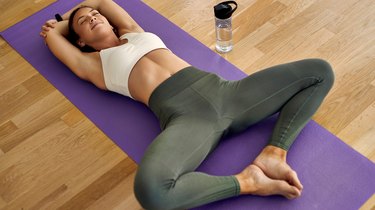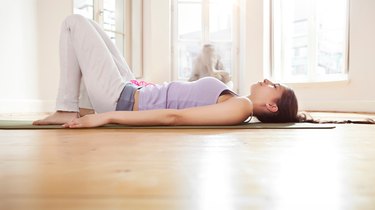
Doing splits is so much more than a cool parlor trick. Indeed, the ability to seamlessly slide into a split is a fantastic feat of flexibility and mobility, which is also why accomplishing the masterful move is so difficult.
So if you're wondering "why can't I do the splits?," Joanie Johnson, CPT, former professional dancer and founder of Strong Mom Society, shares the top five reasons, plus strategies to help you step things up.
Video of the Day
Video of the Day
If You: Can't Fully Extend Your Legs
You Might: Have Tight Hips
Stiff hips can hinder your splits. If your hips and hip flexors can't extend to their full range of motion, your splits will only go so far, Johnson says.
Many people hold tension in the muscles around their hips from being too sedentary, she says. Likewise, muscular imbalances, weakness, overuse and injury are also common sources of inflexible hip flexors.
Fix It
Johnson suggests performing targeted stretches, such as pigeon pose and a kneeling hip flexor stretch, to improve hip flexibility.
Also, keep in mind: “Flexibility comes with mobility,” Johnson says. To be limber, you must move your muscles often — and through their full range of motion — otherwise they grow tight or weak, she explains. In addition to stretches, incorporate hip-strengthening exercises to improve mobility.
Pigeon Pose

- Sit on the floor with one leg bent in front of you and the other leg extended behind you.
- Try to keep both hips pointing down toward the floor.
- Rest your hands on your thighs, hips or out in front of you, then switch legs.
Kneeling Hip Flexor Stretch

- Start in a kneeling position with the left knee on the floor directly under the left hip and the right foot planted on the ground. Your right leg should make a 90-degree angle.
- Without arching your low back, brace your core and tuck your tailbone by pushing your butt forward.
- Squeeze the glute muscles on your left side to increase the stretch and hold.
- Then, switch legs and repeat on the opposite side.
If You: Can't Stabilize Your Pelvis
You Might: Have Tight Hamstrings
Tense hamstrings are another reason you can't do the splits. "Tight hamstrings will pull your pelvis out of its neutral position, often causing back pain and limiting mobility," Johnson says. And this will affect your ability to achieve your splits. The improper positioning of your pelvis will pull on your low back, knees and pelvic bones, she explains.
Fix It
Try doing the simple stretches below daily to release tightness in your hamstrings. Remember to also make mobility a priority.
“Just trying to stretch without focusing on mobility can lead to injury because the muscles aren’t accustomed to moving in that way,” Johnson says.
To help loosen tight hamstrings, it’s a good idea to do mobility exercises like leg swings, kicks and squats (or even a little bit of light cardio) to get the muscles moving and the blood flowing, she says.
Seated Forward Bend

- Sit up tall with your legs together. Engage your quadriceps (tops of thighs) to lengthen your hamstrings. You can have a slight bend in the knees.
- Bend forward from your waist and reach for your shins, ankles or toes while maintaining a long spine and straight legs.
Half-Kneeling Split

- From a kneeling position, step one foot forward between your hands and extend the leg in front of you.
- Keep your hips square and stacked over your knee as you flex your front foot and begin to fold over your front leg.
- Switch legs and repeat on the opposite side.
If You: Have Tightness in Your Groin
You Might: Lack Flexibility in Your Inner Thighs
"When people feel like they 'pulled a groin' when doing splits, it's usually because of tightness in the inner thighs," Johnson says. "Your inner thighs, or adductors, run along the inside of your thigh and are responsible for drawing your legs toward one another and assisting in hip flexion and extension."
So, when your adductors aren't agile, your splits will suffer.
Fix It
When it comes to flexibility: If you don’t use it, you lose it. “Most of us tend to sit or stand in one position for too long during the day, causing everything to tighten,” Johnson says. Your muscles — including your adductors — become like a very tight elastic band that doesn’t have much give.
To combat this, Johnson recommends doing the butterfly stretch. This three-in-one move eases tension in your inner thighs, hips and low back.
And again, focus on mobility exercises. “If you increase your mobility and range of motion, you’ll more easily be able to increase your stretch,” Johnson says.
Butterfly Stretch

- Sit tall with the soles of your feet together and let your knees bend out to the sides.
- Hold your feet with your hands while pulling your heels toward you.
- Without bouncing, bend forward while maintaining a straight back.
If You: Can't Sit Comfortably on the Ground
You Might: Have Tension in Your Pelvic Floor
"The pelvic floor muscles line the entire bowl of the pelvis and consist of five layers of connective fascia," Johnson says. Tightness in this area can seriously impact your flexibility and mobility, especially since all the muscles in your pelvic floor, core and lower body are interconnected.
Often, tension in the pelvic floor affects the muscles surrounding the hips and adductors, which we already know play a role in your ability to perform proper splits, Johnson says.
Fix It
“Making sure that your pelvic floor is relaxed as you practice your splits will eliminate excess tension to these areas,” Johnson says.
Pelvic Floor Relaxation Exercise

- Lie on your back with the soles of the feet together and knees bent out to the sides.
- Place both hands behind your head and practice fully expanding your lower belly.
If You: Have Tight Hip Flexors
You Might: Have a Stiff Lower Back
A sneaky reason you can't do the splits? Lack of mobility in your low back.
But an inflexible low back is usually a symptom of another problem like compensation for tightness or weakness in a surrounding muscle, Johnson says. An unbending back can also be a sign that you're breathing incorrectly, she adds.
Fix It
“There are exercises you can do to stretch your low back, but it’s more important to get to the root of the problem,” Johnson says.
For example, tight iliopsoas (hip flexors) are a common culprit for a stiff back. When your hip flexors are too tense, they can cause lordosis — an excessive inward curve of your lower back, Johnson says. To relieve a rigid back, you may first need to contend with your hip flexors. (Try doing the kneeling hip flexor stretch above.)
Similarly, a lot of back pain may come from not breathing diaphragmatically. “When you’re a chest breather, you take more shallow breaths, which results in tightening and shortening of your back muscles,” Johnson says. Thus, practicing deep breathing throughout your day can help release your back muscles.
“Once you feel the difference between breathing with your chest and your belly (diaphragm), slowly work your way up to standing and see if you can maintain that same belly breath,” Johnson says.
Diaphragmatic Breathing

- Lie on your back with your knees bent. Place one hand on your chest and one on your belly.
- Focus on feeling your belly rise with every inhale and fall with every exhale.